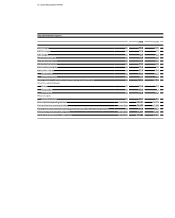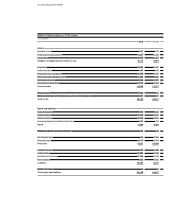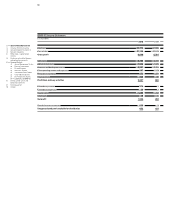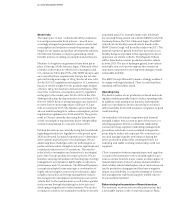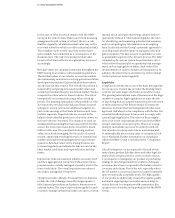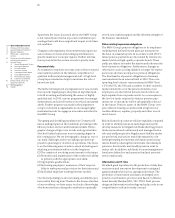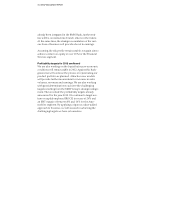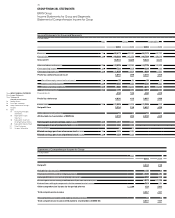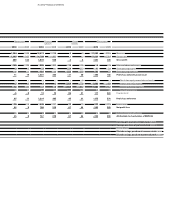BMW 2010 Annual Report Download - page 69
Download and view the complete annual report
Please find page 69 of the 2010 BMW annual report below. You can navigate through the pages in the report by either clicking on the pages listed below, or by using the keyword search tool below to find specific information within the annual report.67 GROUP MANAGEMENT REPORT
In the case of vehicles which remain with the BMW
Group at the end of a lease (leases and credit financing
arrangements with option of return), there is a risk
thatthe originally calculated residual value may not be
recovered when the vehicle is sold (residual value risk).
The vola tility of pre-owned car prices on the major
salesmarkets has intensified as a consequence of the
financial crisis. The risk of incurring residual value
losses in the Financial Services segment has increased
accordingly.
Residual values are calculated uniformly throughout the
BMW Group in accordance with mandatory guidelines.
The residual values of our vehicles on used car markets
are continuously monitored over long periods and future
developments projected. External market observations
are also used in this context. The overall risk position is
measured by comparing forecasted market values and
contractual residual values by model and market. We also
compute the return ratio for leased vehicles. The risk of
unexpected loss is measured using a value-at-risk ap-
proach. The resulting revaluation of the portfolio of vehi-
cles exposed to residual value risks and losses incurred
selling pre-owned cars had an additional negative im-
pact on the earnings of the Financial Services and Auto-
mobiles segments. Expected risks are covered in the
balance sheet either by provisions or by write-downs on
the lease vehicles concerned. The situation on used car
markets stabilised during the financial year 2010. For this
reason, the level of provision did not need to be raised
further inthis area. We counteract declining residual
values by actively managing the life cycles of current
models, optimising reselling processes on international
markets and implementing targeted price and volume
measures. Residual values in the leasing business are
reviewed regularly and adjusted to take account of the
latest market conditions and expected future develop-
ments.
Interest rate risks are measured initially at country level
and then aggregated at Group level. Maximum risk ex-
posures are also initially managed at country level in the
form of risk limits. The overall exposure from interest
rate risks is managed at Group level.
Operational risks relating to Financial Services business
include the risk of damage caused by inappropriate or
failed internal procedures and systems, human error or
external factors. The scope of procedures applied in each
country to manage operational risks is set out in a Group
manual which, amongst other things, addresses the re-
quirements of Basel II. This manual stipulates the rules
for identifying and measuring potential risk scenarios
and for computing key risk indicators on an ongoing
basis. It also sets out the Group’s systematic approach to
recording losses and the nature of any agreed risk-miti-
gation measures. We take account of qualitative as well
as quantitative aspects in the decision process. The latter
is backed up by various system-based solutions, all of
which follow the principles of operational risk manage-
ment, such as segregation of duties, dual control, the
documentation of system changes and transparency. In
addition, the effectiveness and efficiency of the internal
control system are tested regularly.
Legal risks
Compliance with the law is one of the basic prerequisites
for our success. Current law provides the binding frame-
work for our wide range of activities around the world.
The growing international scale of business and the huge
number of complex legal regulations increase the risk
oflaws being broken, simply because they are not known
or fully understood. We therefore take all necessary
measures to ensure that our management bodies, man-
agers and staff always act in compliance with the law. It is
essential for all employees to know and to comply with
current legal regulations. The extent of those regula-
tions
is set out in corporate guidelines and in the BMW
Group’s stated set of core principles. However,
wrong-
doing by individuals can never be entirely ruled out.
Our
objective is to keep such risks to a minimum and
tosystematically uncover any cases of corruption, brib-
ery
or blackmail. Further information on compliance
within the BMW Group is included in the “Compliance
Report”.
Like all enterprises, we are exposed to the risk of war-
ranty claims, product liability claims and other legal dis-
putes which are typical for the sector or which arise as
acon sequence of realigning our product or purchasing
strategy to suit changed market conditions. Adequate
provisions have been recognised in the balance sheet to
cover any such claims. Part of the risk, especially where
the US market is concerned, has been insured ex ternally
up to economically acceptable levels. The high quality
ofour products, additionally ensured by regular quality
audits and ongoing improvement measures, helps to
reduce this risk. In comparison with competitors, this
cangive rise to benefits and opportunities for the BMW
Group.


